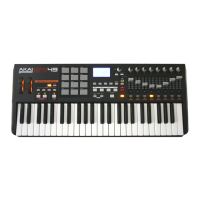
Do you have a question about the Akai MPK 49 and is the answer not in the manual?
| Type | MIDI Keyboard Controller |
|---|---|
| Knobs | 8 assignable Q-Link knobs |
| Faders | 8 assignable Q-Link faders |
| Arpeggiator | Yes |
| Transport Controls | Yes |
| Keys | 49 |
| Pads | 12 MPC-style pads with velocity and pressure sensitivity |
| Buttons | 8 |
| MIDI I/O | MIDI In, MIDI Out |
| USB | USB |
| Display | LCD |
| Power | USB |
| Software Included | Ableton Live Lite |
| Pedal Inputs | Sustain and Expression |
Details on the LCD screen for menus, data display, and navigation buttons.
Explanation of buttons like PRESET, EDIT, GLOBAL, PREVIEW, and PROGRAM CHANGE.
Information on ASSIGNABLE KNOBS, SLIDERS, BUTTONS, and CONTROL BANK.
Details on the 12 MPC pads, PAD BANK buttons, FULL LEVEL, and 12 LEVEL.
Explanation of NOTE REPEAT, TIME DIVISION, ARP ON/OFF, and LATCH functions.
Information on OCTAVE buttons, TAP TEMPO, and PITCH/MODULATION WHEELS.
Details on DC power input, adapter restraint, and USB connection.
Explanation of MIDI OUT, MIDI IN, SUSTAIN PEDAL, and EXPRESSION PEDAL inputs.
Diagram and steps for connecting the MPK49 via USB to a computer.
Diagrams for connecting to external sound modules or controllers.
Ensuring proper connection before launching software applications.
Setting the MPK49 as a default MIDI input device in software preferences.
Slaving the MPK49 to DAW MIDI Clock for Arpeggiator/Note Repeat sync.
Shows current octave and transposition settings on the LCD.
Displays MIDI Note Number, Port, Channel, and velocity upon pad hit.
Shows aftertouch data as pressure is applied to pads.
Displays CC Number, value, and MIDI Channel for controllers.
Displays aftertouch information transmitted by knobs/sliders.
Shows MMC command status for transport control.
Displays controller values in Preview mode.
Explains benefits of precise control and avoiding erroneous data.
Load, save, and copy presets for quick configuration recall.
Customize behavior of keyboard, pads, knobs, and sliders.
Set global parameters like pad response and LCD brightness.
Transmit Program Change messages to switch sounds on devices.
Steps to select and load presets using the VALUE dial.
Instructions for saving or copying current preset configurations.
Assigning custom names to presets for easier identification.
Step-by-step guide to entering and navigating Edit Mode.
Parameters available for editing keyboard settings.
Parameters available for editing pad event types.
Parameters available for knobs and sliders (CC, Aftertouch).
Parameters available for button event types.
Setting the MIDI channel for keyboard transmission.
Adjusting the default octave shift for the keyboard.
Enabling or disabling Aftertouch transmission for the keyboard.
Enabling or disabling velocity sensitivity for the keyboard.
Explanation of MIDI Note On/Off messages for triggering sounds.
Explanation of Program Change messages for switching sounds.
Setting the MIDI Port and Channel for pad transmission.
Setting the MIDI Note Number transmitted by the pad.
Choosing between momentary (MTY) or toggle (TGL) play mode.
Setting the MIDI Port and Channel for program change transmission.
Setting the Program Change Number transmitted by the pad.
Setting Bank Most Significant Bit (MSB) and Least Significant Bit (LSB).
Explanation of MIDI Continuous Controller (CC) data.
Explanation of Aftertouch data for knobs and sliders.
Setting MIDI Port and Channel for control change transmission.
Assigning the Control Change Number for knobs and sliders.
Setting minimum and maximum values for control change output.
Setting MIDI Port and Channel for aftertouch transmission.
Setting minimum and maximum values for aftertouch output.
Setting MIDI channel for increment/decrement NRPN function.
Setting MSB and LSB for NRPN increment/decrement.
Configuration for buttons transmitting Control Change events.
Setting MIDI Port and Channel for program change transmission.
Setting the Program Change Number for buttons.
Setting Bank MSB and LSB for button program changes.
Settings for Arp Type, Range, and Button Mode.
Settings for Arpeggiator Gate duration and Swing offset.
Choosing between Arp Types: Up, Down, Incl, Excl, Rand, Chrd.
Selecting the arpeggiator range in octaves.
Selecting momentary or toggle behavior for the ARP ON/OFF button.
Setting the duration of the arpeggiated notes.
Setting the swing offset for arpeggiated notes.
Setting momentary or toggle fashion for the NOTE REPEAT button.
Setting duration (Gate) and offset (Swing) for repeated notes.
Choosing between momentary (MTY) or toggle (TGL) for the NOTE REPEAT button.
Adjusting Gate duration and Swing offset for Note Repeat.
Setting the default time division for when a Preset is loaded.
Setting momentary or toggle fashion for the TIME DIVISION button.
Selecting the MIDI channel for Pitch Bend wheel transmission.
Specifying the MIDI channel for modulation wheel transmission.
Specifying the MIDI CC number for modulation wheel transmission.
Setting minimum and maximum values for modulation wheel output.
Selecting format for transport control messages (MMC, MIDI, CTRL).
Adjusting the tempo value for the current Preset.
Sending ALL NOTES OFF or RESET ALL CONTROLLERS messages.
Assigning the MIDI Common Channel to a desired MIDI Channel.
Adjusting the contrast level of the LCD display.
Adjusting how sensitive the pads are to touch.
Optimizing pad velocity output based on playing style.
Setting the minimum force required to activate the pads.
Transposing the MPK49's keyboard up or down.
Synchronizing devices or determining Note Repeat/Arpeggiator note location.
Setting the number of taps used for TAP TEMPO AVERAGE.
Saving all global parameters and preset/SysEx information.
Transferring Preset data or SysEx information via SysEx.
Displaying the operating system and firmware version.
Transmitting a regular Program Change message (0-127).
Transmitting Program Change with Bank L and Bank M messages.